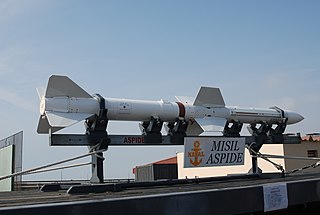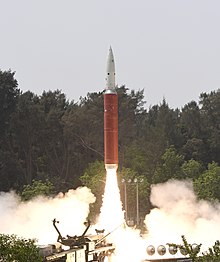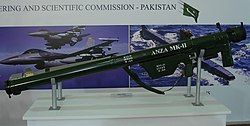
A missile is an airborne ranged weapon capable of self-propelled flight aided usually by a propellant, jet engine or rocket motor.

A ballistic missile (BM) is a type of missile that uses projectile motion to deliver warheads on a target. These weapons are powered only during relatively brief periods—most of the flight is unpowered. Short-range ballistic missiles (SRBM) stay within the Earth's atmosphere, while intercontinental ballistic missiles (ICBM) are launched on a sub-orbital flight. They are internally guided – those for short range are typically inertial-guided while those for long range typically have more sophisticated guidance.

An intermediate-range ballistic missile (IRBM) is a ballistic missile with a range of 3,000–5,500 km, between a medium-range ballistic missile (MRBM) and an intercontinental ballistic missile (ICBM). Classifying ballistic missiles by range is done mostly for convenience; in principle there is very little difference between a low-performance ICBM and a high-performance IRBM, because decreasing payload mass can increase range over ICBM threshold. The range definition used here is used within the U.S. Missile Defense Agency. Some other sources include an additional category, the long-range ballistic missile (LRBM), to describe missiles with a range between IRBMs and true ICBMs. The more modern term theatre ballistic missile encompasses MRBMs and SRBMs, including any ballistic missile with a range under 3,500 km (2,175 mi).

A medium-range ballistic missile (MRBM) is a type of ballistic missile with medium range, this last classification depending on the standards of certain organizations. Within the U.S. Department of Defense, a medium-range missile is defined by having a maximum range of between 1,000 and 3,000 kilometres. In modern terminology, MRBMs are part of the wider grouping of theatre ballistic missiles, which includes any ballistic missile with a range of less than 3,500 kilometres (2,200 mi). Roughly speaking, MRBM covers the ranges over SRBM (tactical) and under IRBM.

A short-range ballistic missile (SRBM) is a ballistic missile with a range of about 1,000 km (620 mi) or less. In past and potential regional conflicts, these missiles have been and would be used because of the short distances between some countries and their relative low cost and ease of configuration. In modern terminology, SRBMs are part of the wider grouping of theatre ballistic missiles, which includes any ballistic missile with a range of less than 3,500 km.
A surface-to-surface missile (SSM) or ground-to-ground missile (GGM) is a missile designed to be launched from the ground or the sea and strike targets on land or at sea. They may be fired from hand-held or vehicle mounted devices, from fixed installations, or from a ship. They are often powered by a rocket engine or sometimes fired by an explosive charge, since the launching platform is typically stationary or moving slowly. They usually have fins and/or wings for lift and stability, although hyper-velocity or short-ranged missiles may use body lift or fly a ballistic trajectory. The V-1 flying bomb was the first operational surface-to-surface missile.

Aspide is an Italian medium range air-to-air and surface-to-air missile produced by Selenia. It is provided with semi-active radar homing seeker. It is very similar to the American AIM-7 Sparrow, using the same airframe, but uses an inverse monopulse seeker that is far more accurate and much less susceptible to ECM than the original conical scanning version.

The National Engineering & Scientific Commission (NESCOM) is a Pakistani government-funded defense contractor that develops, designs and sells defense hardware, including missile and weapon systems. It was funded and formed by the Government of Pakistan to develop its domestic production of weapon system.

NPO Novator is a Russian company that designs long-range anti-aircraft missiles. It was established in 1947 as OKB-8 in Sverdlovsk, became independent in 1991, and then became part of the Almaz-Antey conglomerate. It is perhaps best known for designing the 9M82 and 9M83 missiles of the S-300V SAM system.

The RIM-174 Standard Extended Range Active Missile (ERAM), or Standard Missile 6 (SM-6), is a missile in current production for the United States Navy. It was designed for extended-range anti-air warfare (ER-AAW) purposes, providing capability against fixed and rotary-wing aircraft, unmanned aerial vehicles, anti-ship cruise missiles in flight, both over sea and land, and terminal ballistic missile defense. It can also be used as a high-speed anti-ship missile. The missile uses the airframe of the earlier SM-2ER Block IV (RIM-156A) missile, adding the active radar homing seeker from the AIM-120C AMRAAM in place of the semi-active seeker of the previous design. This will improve the capability of the Standard missile against highly agile targets and targets beyond the effective range of the launching vessels' target illumination radars. Initial operating capability was planned for 2013 and was achieved on 27 November 2013. The SM-6 is not meant to replace the SM-2 series of missiles but will serve alongside and provide extended range and increased firepower. It was approved for export in January 2017.

The Korean People's Army Strategic Force, previously known as the Korean People's Army Strategic Rocket Force, is a military branch of the Korean People's Army (KPA) founded in 2012 that operates surface-to-surface missiles in the nuclear and conventional strike roles. It is mainly armed with ballistic missiles; the inventory includes domestic and Soviet designs.
The Hwasong-5 is a North Korean short range ballistic missile (SRBM) derived from the Soviet R-17 Elbrus missile. It is one of several missiles with the NATO reporting name Scud-B.

Missile defense systems are a type of missile defense intended to shield a country against incoming missiles, such as intercontinental ballistic missiles (ICBMs) or other ballistic missiles. The United States, Russia, India, France, Israel, Italy, United Kingdom, China and Iran have all developed missile defense systems.
Çakır is a new generation cruise missile that can be launched from land, sea and air platforms with a range of more than 150 km (93 mi), designed by Turkish rocket and missile manufacturer Roketsan. It was introduced with the launch of Roketsan Ankara Lalahan facilities on 31 March 2022. On the same day, a video about the missile was shared on the Twitter account of Roketsan.























